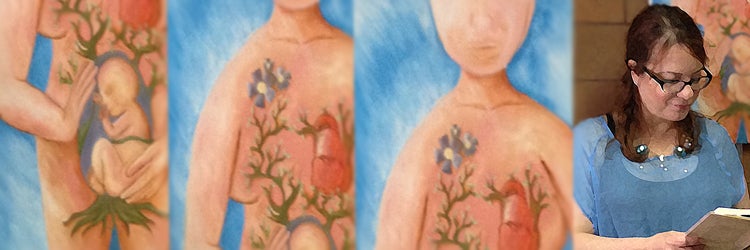Moving History: Greta Kroeker’s Hands-On Teaching
 |
| Greta Kroeker, along with one of her student's paintings. |
Written by Victoria Faraci, Special Projects (Teaching Stories), CTE.
Enter Dr. Greta Kroeker’s office and you’ll think you’ve been transported back in time. Handmade crafts abound: an apron, a necklace, a wooden birthing stool. Visual art adorns her walls, including a splendid painting that recalls the work of the fifteenth-century artist Hieronymus Bosch. All of these items were made by Kroeker’s students in her History 347 “Witches, Wives, and Whores” course. With numerous student pieces on hand, as well as research papers and replica journals, she excitedly moves around her space, explaining the creative genius behind these many artifacts.
Kroeker opens up the past for her students, encouraging them to immerse themselves in history through classroom simulations. This year, in her “Witches, Wives, and Whores” course, one group of students staged a traditional wedding ceremony, while another group explored a sixteenth-century witch trial by enacting a mock “burning at the stake” in Uptown Waterloo. Such projects give students an active role in their learning, motivating them to deeply engage with the course content. “I want them to build on their critical thinking and research skills,” Kroeker says. “I get a lot out of the class and I hope that they do too.” Dr. Heather McDougall, Associate Professor and Acting Chair of the Department of History, asserts that Kroeker’s course is an example of “hands-on history,” blending traditional scholarship with experiential learning.
Kroeker constantly strives to improve her courses. To this end, she solicits ongoing feedback from her students. She notes that one of the most important things she has learned from years of teaching is to really listen to her students. “Listening to them enriches what I am able to give them.” With this in mind, Kroeker has worked hard to make her lectures engaging for students. “It’s very important,” she says, “not to lose students along the way… I always have to keep the momentum in those big lecture courses.” Accordingly, she aims in her lectures to conjure a seamless historical narrative for her students, sometimes even acting things out in class.
In her classroom, Kroeker uses the first hour to lecture on that day’s assigned readings. The students are also responsible for a series of reading logs due at the beginning of class. The rest of the class is devoted to informed discussion of the readings and to group work.
Teaching on and off since the age of eighteen, Kroeker’s passion for teaching is driven by her belief that teachers have the power to help shape young people’s sense of identity. “I really believe in the power of history,” she says. “I think that teaching history teaches empathy,” something this crowded planet could use a bit more of, she adds.
In terms of her own research, Kroeker says that “there is no more energizing and exciting impetus for continued research than having a classroom like this.” Kroeker is inspired by “the generosity of spirit” she witnesses as her students cooperate and collaborate in the name of creativity. When asked what she wants students to take away from her class, Kroeker says, “Dates I don’t care so much about, but I want them to grasp how history moves so that they can move history.” With this seemingly simple sentiment, Kroeker gives her students the tools they need to become critical, yet creative, thinkers.
On October 30, 2013, Dr. Kroeker, along with some of her students, will present on her Witches, Wives, and Whores course as part of CTE's Fall 2013 Integrative and Experiential Learning Series.
CTE has developed more than 100 Teaching Tips. Each one is a succinct document that conveys useful ideas and practical methods for effective teaching. Some of the Teaching Tips that are relevant to the strategies mentioned in this Teaching Story include the following: